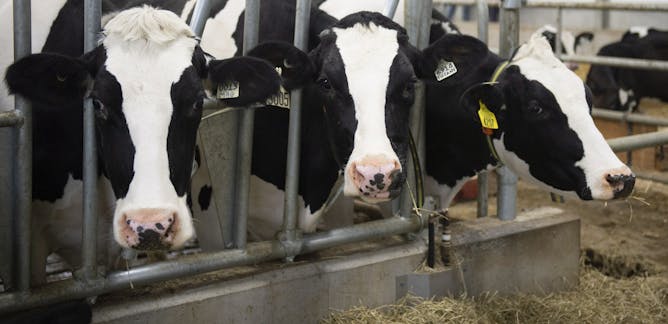
Articles sur Bird flu
Affichage de 1 à 20 de 43 articles

Bird flu in U.S. dairy cows has Canadian public health experts on high alert. With one human case identified in Texas, what is the likelihood of H5N1 influenza moving from birds to mammals to people?

For now there’s no spread of H5N1 between humans, which is good news. But bird flu is evolving, and we need to stay vigilant.

People should minimise contact with birds in areas affected by bird flu viruses, including farms and settings where live animals may be sold or slaughtered.

Bird flu is decimating species already threatened by climate change and habitat loss.

Avian influenza has killed a polar bear and may have infected other bears.

A deadly strain of bird flu is circulating in animals. So far the virus has been detected in seabirds on islands near Antarctica. What does this mean for wildlife, tourism and research?

Vaccinating livestock against common disease not only improves animal welfare, it’s good for the planet too.

The three flu pandemics of the 20th century originated from birds, making it critical to fight bird flu. Breakthroughs in gene-editing chickens show promise for eliminating the disease in the future.

New and innovative thinking is needed to deal with the reality on the ground in South Africa.

Australia’s biosecurity system is on high alert for alien invaders. Here’s a hit list of eight baddies we believe pose the greatest threat to Australia’s biodiversity.

The first sign of a new bird flu might be a dead seabird or marine mammal. Better surveillance of migratory birds and wildlife – and better public awareness – is crucial.

After previous public health emergencies likes SARS and H1N1, there was renewed investment in pandemic preparedness, but it was not sustained. We cannot make the same mistake after COVID-19.

From cancer immunotherapy and antibiotics to GMO crops and pandemic surveillance, gain of function is a cornerstone of basic research.

From September onwards, migratory birds will arrive on Australian shores. If one is carrying the lethal bird flu, it could devastate our birdlife

This latest outbreak has been deadly for many millions of birds. The risk to humans, however, is very low.

Similar to the patterns seen with COVID-19, flu and RSV, HMPV is making a comeback after years of being repressed by people wearing masks and social distancing.

Avian influenza — commonly known as ‘bird flu’ — is infecting domestic and wild birds in Canada and around the world.

Bird flu has been recurring in Africa since 2006 and Nigeria is heavily affected. High-level biosecurity measures are required to keep people and animals safe.

Avian influenza viruses have evolved to infect birds, but the current H5N1 outbreak is also infecting a wide range of mammals. This suggests that it could mutate into forms that threaten humans.

Though preferable to battery farms, free-range eggs are not as safe and ethical as customers think.
